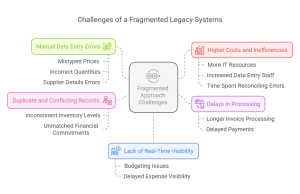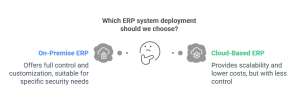16.2 Enterprise Resource Planning (ERP)
To understand how operations worked in a legacy system, consider a basic procurement process between a supplier and a buyer. Suppose a company orders raw materials from a supplier. The supplier creates an invoice, which might be in paper format or in a digital format that the buyer’s system cannot read. Since the buyer’s procurement system cannot automatically process this invoice, an employee must manually enter the details into the company’s system. Once the materials arrive, the receiving department needs to record the delivery and verify that the correct quantity was received. However, since the receiving department has its own separate system, it must generate a goods receipt document and send it to the accounts payable department for payment processing. Again, because accounts payable uses a different system, the data must be entered manually once more before the payment can be approved.
This fragmented approach leads to several key challenges:
- Manual Data Entry Errors – Every time information is re-entered manually, there is a risk of mistyping prices, quantities, or supplier details, leading to incorrect payments or mismatched records.
- Delays in Processing – Since information does not flow automatically between departments, invoices, receipts, and payments take longer to be processed, causing delays in financial settlements and supplier relationships.
- Duplicate and Conflicting Records – Without a centralized database, different departments may have inconsistent data, making it difficult to track inventory levels, financial commitments, and supplier transactions accurately.
- Lack of Real-Time Visibility – Managers and decision-makers cannot access up-to-date information because records exist in separate systems. For example, procurement might place an order, but finance might not immediately see the expense, leading to budgeting issues.
- Higher Costs and Inefficiencies – Maintaining multiple systems for different functions requires more IT resources, more employees for data entry, and more time spent reconciling errors, increasing overall business costs.

To solve these problems, businesses implement Enterprise Resource Planning (ERP) systems, which replace multiple standalone systems with a single integrated platform. ERP ensures that all departments use the same data, eliminating the need for manual entry and allowing real-time information sharing across the organization. For example, in an ERP system, when a supplier sends an invoice, it can be automatically matched with the purchase order and goods receipt, enabling instant approval for payment without re-entering data. Similarly, when inventory is updated in the warehouse, procurement and finance can see the changes immediately, improving coordination and decision-making.
By eliminating the inefficiencies of legacy systems, ERP allows companies to streamline operations, reduce costs, and improve accuracy, making supply chain processes far more efficient and reliable.
16.2.1 ERP Modules
One of the key features of Enterprise Resource Planning (ERP) systems is that they are built in separate functional units called modules. Instead of having a single massive program handling everything, an ERP system consists of individual modules, each designed for a specific business function. For example, there are modules for finance, human resources, supply chain management, customer relationship management, and production planning. These modules work independently but are also connected, meaning that data flows smoothly across departments. This allows companies to integrate different business functions into a single system without needing multiple disconnected software solutions.
A major advantage of this modular structure is that companies can start small and expand gradually. Businesses do not have to install the entire ERP system at once; they can implement only the modules they need and add more as they grow. For instance, a small business might begin with just an accounting module to manage finances and later add an inventory management module when they expand operations. Similarly, a retail company might first adopt a sales and customer management module and later include a warehouse management module to track inventory in real time. This step-by-step approach makes ERP systems more flexible and cost-effective, allowing businesses to invest in technology based on their immediate needs while keeping future expansion in mind.
Firms face choices in how they assemble their ERP systems. They can opt for an all-in-one solution from a single vendor, which offers the convenience of a unified system with seamless integration across all modules. Alternatively, companies can select a best-of-breed approach, choosing specific modules from specialized providers that offer advanced functionality in particular areas. For example, a distribution company might purchase most of its ERP modules from one vendor but opt for a warehousing and distribution module from a different provider that offers superior features for inventory management and logistics. This approach allows the company to leverage specialized capabilities that are crucial for its core operations.
Each approach has its advantages and disadvantages. The all-in-one solution simplifies integration and vendor management, often resulting in lower overall system complexity and reduced IT overhead. However, it may not always deliver the best capability in each functional area. The best-of-breed approach, on the other hand, allows companies to capitalize on the most advanced technology available for specific modules but can introduce challenges related to integration, data consistency, and vendor management. These trade-offs must be carefully considered in light of the company’s strategic needs and IT capabilities.
16.2.2 On-premise vs Cloud hosting
ERP systems can be deployed in two main environments: on-premise and in the cloud. On-premise ERP systems are hosted on the company’s own servers and managed by its IT staff, giving the organization full control over the hardware and software. This setup is often preferred by companies that require high levels of customization or have specific data security requirements.
Cloud-based ERP systems, conversely, are hosted on the vendor’s servers and accessed via the internet. This model offers several advantages, such as lower upfront costs, reduced need for internal IT maintenance, and greater scalability. However, it also presents potential downsides, including less control over data storage and dependency on the vendor for uptime and system performance. Companies must weigh these factors against their operational priorities, budget constraints, and strategic IT goals when choosing between on-premise and cloud ERP solutions.

16.2.3 Benefits and challenges
Businesses adopt enterprise resource planning (ERP) systems for various strategic reasons, including expansion, cost reduction, and operational improvements. While the specific benefits realized can vary between companies, some universally acknowledged advantages include:
- Enhanced Operational Efficiency: By automating daily tasks and streamlining business processes, ERP systems significantly reduce the effort required to manage day-to-day operations. This automation extends across the board—from inventory management to order processing and beyond—helping to eliminate manual errors and freeing up staff to focus on more strategic tasks.
- Improved Financial Reporting and Management: ERP systems integrate all financial data into a single, centralized platform, providing powerful and precise real-time reporting capabilities. This integration allows for better financial planning and analysis, helping organizations to maintain detailed audits, manage budgets effectively, and improve financial performance through enhanced visibility into costs and revenues.
- Centralized Data Management: With an ERP system, all critical data is stored in a single, secure database, allowing for improved data consistency and accessibility. Centralized data management ensures that every department accesses the same, up-to-date information, reducing discrepancies and fostering a unified approach to managing business operations.
- Better Decision Making: Integrated data coupled with advanced analytical tools in ERP systems empower business leaders to make more informed decisions. Managers and executives can quickly access vital information, evaluate operational performance in real-time, and adjust strategies swiftly to meet market demands or internal operational needs.
- Increased Agility and Scalability: ERP systems provide the flexibility to adapt to changing business environments and scale operations up or down as necessary. Whether a company is expanding into new markets, introducing new products, or restructuring its operations, ERP systems can adjust to accommodate new business processes and additional users without disrupting existing workflows.
These benefits demonstrate why ERP systems are crucial for modern businesses looking to maintain competitiveness and streamline their operations in today’s dynamic market environments. The adoption of ERP technology not only supports operational and financial improvements but also enhances strategic planning and execution across the enterprise.
However, the implementation of an ERP system is not without its challenges. Introducing an ERP system requires substantial organizational change management, and many companies may not be prepared for the level of transformation required. The initial cost of implementing an ERP system can also be a significant hurdle, particularly for small businesses. For example, the total cost for a small business to implement an ERP system can range from $75,000 to $750,000, depending on the complexity and scope of the deployment.
Additionally, ERP systems require skilled human resources for administration and management. These resources are often scarce and expensive, adding another layer of challenge in maintaining the system efficiently. The combination of high costs, the need for specialized skills, and the extensive change management required can make ERP implementation a daunting task for any organization, emphasizing the need for thorough planning and strategic consideration before undertaking such an initiative.